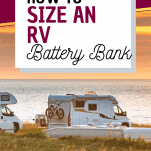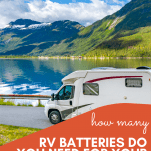RV battery bank is an essential part of your motorhome. It is what powers most of your electrical appliances inside the RV. If you are an RV owner and thinking of going on off-grid camping for a few days, having the right sized battery bank is extremely important. In that case, “How many RV batteries do I need?” – This question must’ve crossed your mind.
In this article, I am going to be discussing how to size RV battery banks, what factors to consider while sizing, and other related information that might be helpful to you.
One 12-volt battery or two 6-volt battery in series configuration can run most of the appliances inside your RV for a decent period before needing a recharge.
Sizing the RV battery bank is a very complex task. A lot of factors affect the size of the battery bank. Knowing and understanding them is crucial for you to find the right size for your RV battery bank. Here are all the things you need to know to make the right decision.
What is a Battery Bank?
Before you can size your battery bank, you need to know what it is. Seeing the word bank, you might think it must be some traditional financial institution for batteries. But that is not the case. When you connect two or more batteries to increase voltage or amps according to your needs, this group of cells is known as a battery bank.
Batteries can be connected using series or parallel connections or a combination of series-parallel connections. A detailed overview of these connections is given below.
Batteries in Series Configuration: In this type of configuration, the positive terminal of a cell is connected to the battery’s negative terminal. The negative terminal will be connected to the positive terminal of another battery. The remaining two terminals will be connected to the appliance you will be using.
This type of battery configuration will increase the voltages but keep the current amount the same. For example, if we add two 6-volt batteries in series, the resultant voltage of the battery bank will be 6 + 6 = 12 volt. But the current will be the same. The voltage and current rating of the connected batteries have to be the same.
Batteries in Parallel Configuration: For this type of configuration, all the positive terminals of the cells are connected in a single common terminal. The same is done for the negative terminals of the batteries. Always connect batteries with the same voltage and current ratings to avoid damage.
This type of configuration will provide the same voltage across the common terminals, but the current will increase. For example, if we connect two 12-volt batteries with a current rating of 60 Ah (Ampere hour) in parallel connection, the resultant voltage across the common terminals will be 12 volts, but the current will increase to 60 + 60 = 120 ampere.
Batteries in Series-Parallel Configuration: For series-parallel configuration, at least four batteries are needed. Batteries with the same voltage and current rating are preferable to avoid any damage.
Series-parallel configuration was achieved by making two pairs of two batteries joined in series connection. These two pairs are later connected in a parallel configuration. This type of configuration can deliver double the ampere-hour relative to other configurations.
Understanding Ampere-Hour
Ampere-hour (Ah) is a unit of electrical charge. A battery having 1 Ah rating means that this battery has enough electrical charge to supply one ampere of electrical current for one hour.
Ampere hour gives us how long we can use a fully charged battery. For example, if we plug in a 12-watt LED light with a battery rated 6 V and 120 Ah capacity, the electrical equipment will use 12 ÷ 2 = 2 ampere of current. So, the battery can power this equipment for 120 ÷ 2 = 60 hours with a full charge.
Sizing RV Battery Bank
Sizing the RV battery bank is a complicated task. We need to find out several important variables to find out the RV battery bank capacity. Every one of these variables is equally vital in finding out the minimum capacity of our battery bank. These variables are discussed briefly here.
1. Estimating Power Usage:
There are two types of appliances inside the RV. Some appliances like Air conditioner, microwave oven, TV, etc. run on AC. On the other hand, LED lights, furnaces, and refrigerators run on DC. The output of the battery bank is DC power. RV battery bank can’t power AC appliances unless the RV has an inverter. Some RVs are equipped with an AC generator.
The first thing you need to do is to determine how much power you will use on your camping trip. Make a list of all the electrical equipment that you are going to use in your camp. Check how much power they use per hour. Assume how long you will use this equipment.
To determine how much electrical power each of them uses, you can check the power rating label on the equipment or check on the manufactures’ website. The total power usage will be expressed in Watt-hour. If you can only find the power usage in kilowatt-hour, multiply it with 1000 to convert it to watt-hour.
If you want to run your AC powered equipment using a battery bank, you will need an inverter. Convert the AC powered appliances power usage into watt-hour. When you find the power draw for each appliance, add them to get the total power usage. This process requires lots of trial and error.
2. Determine System Voltage:
Once you have determined the total power usage, you need to determine the system voltage of the RV. The system voltage is the voltage of the battery bank that is required to run the appliances of the RV. Typically, the system voltage for RV appliances is 12-volt.
3. Depth of Discharge:
Another critical factor is the battery bank depth of discharge. It simply means the percentage of the battery is discharged about the total battery bank capacity. Depth of Discharge or in short DoD is directly related to the battery cycle. A single cycle starts from when the battery is fully charged, depleted through use, and then recharged to its full capacity.
100% DoD means the battery is empty, and 0% DoD means the battery is fully charged. The higher you discharge the battery, the shorter the battery life span will be. For example, a battery discharged 50% daily will have a longer lifespan than a battery that is discharged 60% daily.
So, decide how much your DoD will be. It is recommended that your planned DoD never crosses the manufactures DoD limit.
4. Temperature:
The temperature has a significant impact on battery capacity and life span. A lower temperature reduces battery capacity. On the other hand, the higher temperature reduces the lifespan of the battery. Most battery manufacturers recommend a battery operating temperature of about 77°F or 25°C.
So, wherever you go camping, keep in mind about the highest and lowest possible temperature that your battery is going to be subjected to. Include the temperature effect on your battery bank size calculation by multiplying the factor from the table given below, corresponding to the lowest average temperature your battery will be exposed to.
Table: Recommended Temperature Factors for Battery Sizing
| Averaged Lowest Temperature (in °F) | Multiplier Factor |
| Above 80 | 1.00 |
| 70 – 69 | 1.04 |
| 60 – 69 | 1.11 |
| 50 – 59 | 1.19 |
| 40 – 49 | 1.30 |
| 30 – 39 | 1.40 |
| 20 – 29 | 1.59 |
Calculations:
Now that you have found out all the variables required, you can calculate the minimum size of your battery bank. The battery size is calculated in ampere-hour (Ah). Just follow steps that are used below in our example to calculate your own RV battery bank size.
Let us consider,
- The total electrical power usage during camp time is 250 watt-hours.
- The RV system voltage is 12 volts.
- The planned DoD is 65%.
- The average lowest temperature that the battery will be exposed to is 70°F.
Step 1: Calculate the total power usage. In our case, this is 250 watt-hours.
Step 2: Convert the DoD from percentage to decimals. Here, DoD is 65% or 0.65.
Step 3: Divide the total power usage with the result from step 2. So, 250 ÷ 0.65 = 384.615 Wh.
Step 4: Determine the lowest averaged temperature and find the corresponding factor from the table above. Multiply the factor with the result from step 3. In our case for 70°F the factor is 1.04. So, multiplying it with our result from step 3 we get, 384.615 × 1.04 = 400 Wh.
Step 5: Divide the outcome from step 4 by your system voltage. This will result in the minimum battery capacity in ampere-hours (Ah). So, 400 ÷ 12 = 33.33 Ah.
Choosing the Battery
Before choosing a suitable battery for your RV battery bank, you need to consider some important factors.
Storage Space & Weight:
Before choosing a battery, first, you need to consider how much battery storage space and weight carrying capacity you have on your RV. These batteries weigh a lot. You can determine the weight carrying capacity from the gross weight of your RV. The weights need to be balanced. For that reason, you might have to make a compromise with some of your RV features.
Battery Types:
There are mainly two types of batteries. They are –
1. Deep Cycle Batteries: This is a type of lead-acid battery mainly used in automobiles. Like the battery used in cars. But regular car batteries provide a large amount of current for a small period. On the other hand, these batteries provide a steady current flow for a long time.
Different types of deep cycle batteries are available. They are- Flooded Wet-Cell, Gel type, and Absorbed Glass Mat. Among them, flooded wet-cell batteries are used the most. In this battery, the metal plates are submerged into the electrolytic fluid. These batteries need to be filled with distilled water frequently to keep the plates submerged. Otherwise, it can damage the battery.
Deep cycle batteries are cheap. That’s why they are used in most of the RV battery bank. However, they weigh a lot and have a shorter life span compared to Lithium-ion batteries. These batteries also need a lot of maintenance work.
2. Lithium-Ion Batteries: Lithium-Ion batteries are a recent invention. They are gradually becoming very popular among RV owners. They are lighter, have a longer lifespan. And most importantly, they do not need frequent maintenance work. You can connect the battery and forget about it. But they are very expensive compared to deep cycle batteries.
Building the Battery Bank:
For building the battery bank, choose a battery either deep cycle or lithium-ion battery with the same capacity in Ah that you calculated using the steps above. If you can’t find a battery with a similar ampere-hour rating, try to look for batteries that have half or one-third of the ampere-hour rating. This will give you the number of battery strings that need to connect parallelly.
Once you meet your ampere-hour capacity, you need to consider the battery voltage. Just divide the system voltage with the battery voltage. This will result in the number of batteries we need to connect in a series configuration in each string. Always use the same type of batteries with the same voltage and ampere-hour rating no matter what the configuration is.
RV Battery Bank Maintenance
The maintenance of the battery mainly depends on what type of battery you chose for your battery bank. The lithium-ion batteries require almost no maintenance.
On the other hand, deep cycle batteries require a lot of maintenance work. You can go through your battery manufacturer-provided instruction book for in-depth instruction specific to your battery model. Some basic maintenance instructions are discussed here.
1. Physical Inspection: Check and ensure that your battery has no physical damage, defective wiring, or any leakage that can damage the battery through frequent inspection.
2. Clean Battery Terminals: Keep the battery terminals clean from any dirt or corrosion developed in the terminals.
3. Check the Electrolyte Level: If you are using flooded cell batteries, it is extremely important to keep track of the battery electrolyte level. If the electrolyte fluid falls below the manufacturer specified level, it can damage the battery. Always fill the reservoir with distilled water. Do not overfill it.
4. Temperature: Temperature has a huge impact on battery life span and battery capacity. Do not store the battery where the battery will be exposed to freezing temperatures. It can permanently damage the battery. Also, ensure that the battery is not exposed to overheat. Higher temperature shortens the lifespan of the battery.
5. Charge regularly: As an RV owner, you might store the batteries for a long time before you go camping again. Before storing, charge the battery to its full capacity. Check the battery voltage regularly. And recharge the battery regularly to ensure a longer battery life span.
Frequently Asked Questions
How many batteries do I want in my RV battery bank?
One 12-volt battery or two 6-volt battery in series configuration will be enough to run most of the electrical appliances inside your RV.
How often do I need to change RV batteries?
It depends on the type of battery you are using for your RV battery bank. Traditional deep cycle batteries can last up to 400 to 500 cycles, depending on their depth of discharge. Lithium-ion batteries are superior in this aspect. They can last up to 5000 cycles.
Is the RV battery bank essential for my RV?
To tell you the truth, no. Most of the RVs come equipped with an AC generator that can run all the systems inside your RV. But a battery bank will surely make things easy.
Do all types of deep cycle batteries need water?
No. Only the flooded wet-cell batteries need to be refilled with distilled water if the electrolyte level falls below the limit.
What is the difference between a car battery and an RV battery?
Traditional car batteries provide a large amount of current for a short period. RV batteries provide a steady current level for a longer period. But the chemistry is the same in both cases.
Conclusion
Sizing a battery bank for your RV that will meet your requirements is an extremely difficult task. Too many variables are related to this, and every one of them is equally important. This requires a lot of trial and error, a lot of research and a lot of effort.
Before choosing your battery, do thorough research about different types of batteries. Each type has its pros and cons. The best way to choose is to ask questions to the owners and take their reviews.
After reading the article, I am sure you now understand all you need to know about sizing the RV battery bank. I hope that this guide was somewhat helpful to answer your question, “How many RV batteries do I need for my battery bank?” Thanks for having the patience to go through the whole article. And good luck with your RV battery sizing.




